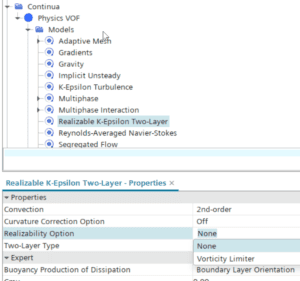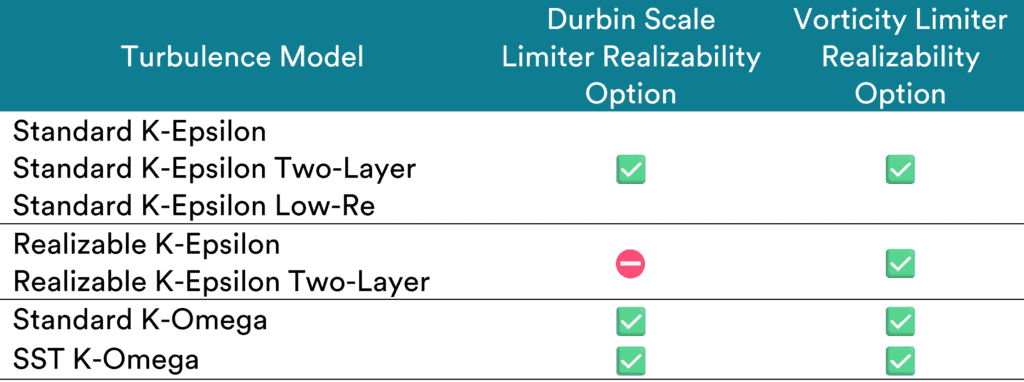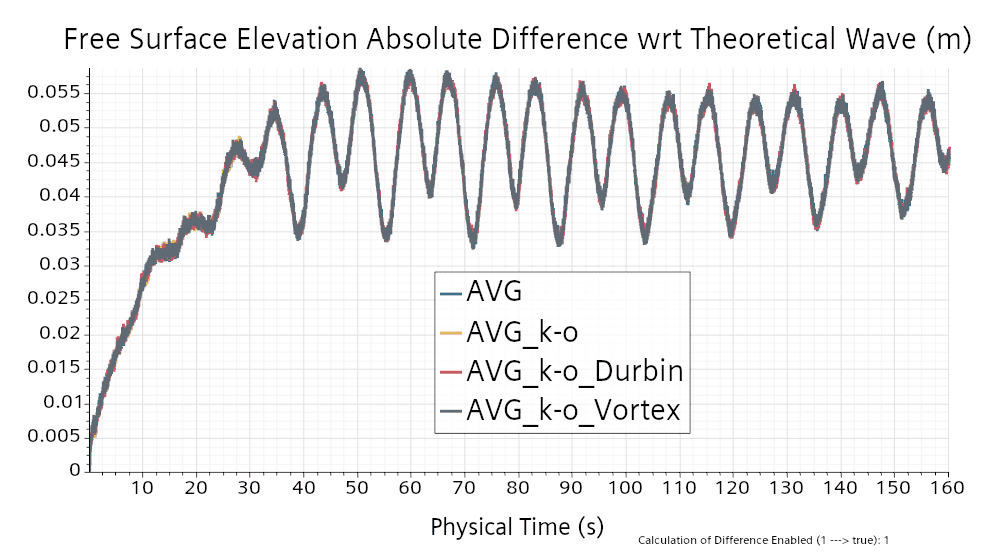The paper “On the k-ε Stagnation Point Anomaly” by Paul A. Durbin, published in 1996, addresses a significant issue with two-equation turbulence models. The paper focuses on the k-ε model that is effective for simulating turbulent flows, yet has notable limitations, especially in its inability to accurately predict turbulent kinetic energy (k) near stagnation points—areas where flow velocity approaches zero.
The anomaly arises from the model’s assumptions and the formulation of the turbulence equations, which do not adequately account for the effects of strong streamline curvature and strain rates that are typical at stagnation points. Specifically, the production term of the turbulence kinetic energy equation is overestimated, which leads to excessive k-values.
Simcenter STAR-CCM+ comes equipped with the realizability constraint on the eddy-viscosity formula to adress this issue.

The turbulent time scale (T) is calculated using Durbin’s realizability constraint. Durbin suggests modifications to the k-ε model by introducing a limit or correction to the production term in the k equation, reducing the overprediction of turbulent kinetic energy. The effect of this constraint can be observed by comparing two simulations of flow over an airfoil: in the first, the realizability option is deactivated, resulting in a noticeable buildup of turbulence at the stagnation point; in the second, the realizability option is activated, leading to improved accuracy.

In the context of free-surface VOF (Volume of Fluid) simulations, two-equation turbulence models often predict excessive turbulent viscosity and steep velocity gradients at the fluid interface. The paper “On the Over-Production of Turbulence Beneath Surface Waves in Reynolds-Averaged Navier-Stokes Models” by Bjarke E. Larsen and David R. Fuhrman (2018) explains that this issue arises from the interaction between the mean flow strain rate and turbulent viscosity, which is amplified by wave motion.
This phenomenon affects wave dynamics, causing a gradual reduction in wave amplitude over multiple wavelengths, which is critical for marine and offshore simulations. The inaccurate turbulence prediction also impacts forces on structures, ship resistance, and wave breaking behavior.
To mitigate this overproduction of turbulence, Simcenter STAR-CCM+ provides a Vorticity Limiter option, which applies a vorticity coefficient constraint to dampen turbulence. This option is particularly useful in VOF wave simulations and can be enabled by setting the Realizability Option of the k-ω or k-ε turbulence models to “Vorticity Limiter.” This method is available exclusively for VOF wave simulations using the VOF Waves model.

The effect of this coefficient can be demonstrated by observing the difference between two solutions of ship waves shown below. In the first solution, where the Vorticity Limiter realizability option is not activated, wave damping occurs. In the second solution, where the Vorticity Limiter realizability option is activated, the wave amplitude (position in Z) is preserved.
Manual: Home > Physics Simulation > Turbulence > Reynolds-Averaged Navier-Stokes (RANS) Turbulence Models > K-Omega Turbulence > Controlling a K-Omega Model
Limiter Availability for Different Models:
All two-equation turbulence models in Simcenter STAR-CCM+ now offer the Vorticity Limiter option. The Durbin Scale Limiter, however, is available for all models except the Realizable k-ε models, as the Realizable k-ε variants already incorporate mechanisms that address some of the shortcomings of the standard k-ε model, including the stagnation point anomaly.

Performance of Limiters in Wave Simulations:
The Vorticity Limiter, proposed by Larsen and Fuhrman, specifically targets the overproduction of turbulence beneath surface waves in RANS models. Therefore, it is expected to be more effective in wave simulations compared to Durbin’s Limiter, which is designed for stagnation points rather than wave dynamics.
To test model behavior, we run simulations using the “Forced Wave Tank” suggested by SIEMENS (https://support.sw.siemens.com/knowledge-base/KB000037234_EN_US) to simulate pure wave propagation. In these quasi-2D simulations, the Realizable k-ε model—a frequent choice for k-ε models—serves as a reference due to its built-in limiters. The SST k-ω model is likely to benefit most from the new Vorticity Limiter.

Without any limiter, simulations show spikes in the Turbulent Viscosity Ratio at the VOF interface. The Durbin Limiter reduces the increase at the free surface, but it fails to fully control the growth. The Vortex Limiter omits extensive growth, but only the Realizable k-ε model effectively keeps the Turbulent Viscosity Ratio low throughout the domain.


Despite differences in turbulence behavior, all models—including the SST k-ω—produce accurate wave propagation results. For a typical Mediterranean wave (400 m wavelength, 20 m height), the average deviation between the theoretical and simulated interface is less than 5 cm.
Summary:
The Durbin Limiter addresses overprediction of turbulence near stagnation points in the two-equations turbulence models, while Larsen and Fuhrman’s Vorticity Limiter focuses on reducing excessive turbulence beneath VOF free surface. Each method is tailored to specific flow conditions. Although the Durbin Limiter helps stabilize the SST k-ω model in some cases, it is not the most suitable approach for marine wave applications. The implementation of the Vorticity Limiter enhances the accuracy of wave-induced turbulence modeling, making it a valuable addition for offshore and marine simulations.
If you like to discuss turbulence modelling with us please feel free to contact us at support@volupe.com.
The Author
Florian Vesting, PhD
Contact: support@volupe.com
+46 768 51 23 46



